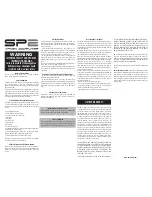
CHAPTER 4: PROGRAMMING
S4 ALARMS/CONTROL
PQM POWER QUALITY METER – INSTRUCTION MANUAL
4–43
•
CURRENT UNBALANCE LEVEL:
When the current unbalance equals or exceeds this
level, a current unbalance condition will occur. See chapter 5 for details on the method
of calculation.
•
CURRENT UNBALANCE DELAY:
If the current unbalance equals or exceeds the
CURRENT UNBALANCE LEVEL
value for the time delay programmed in this setpoint,
a current unbalance condition occurs.
•
VOLTAGE UNBALANCE RELAY:
Voltage unbalance is calculated as the maximum
deviation from the average divided by the average three phase voltage. Voltage
unbalance can either be disabled, used as an alarm or as a process control. Set this
setpoint to off if the feature is not required. Selecting alarm relay will cause the alarm
relay to activate and display an alarm message whenever a voltage unbalance
condition exists. Selecting auxiliary relay will cause the auxiliary relay to activate for a
voltage unbalance condition but no message will be displayed. This is intended for
process control.
•
VOLTAGE UNBALANCE LEVEL:
When the voltage unbalance equals or exceeds this
level, a voltage unbalance condition occurs. See chapter 5 for details on the method of
calculation.
•
VOLTAGE UNBALANCE DELAY:
If the voltage unbalance equals or exceeds the
VOLTAGE UNBALANCE LEVEL
setpoint value and remains this way for the time delay
programmed in this setpoint, a voltage unbalance condition will occur.
•
VOLTAGE PHASE REVERSAL:
Under normal operating conditions, the PQM expects to
see the voltages connected with a 1-2-3 or A-B-C sequence. If the voltages are
connected with the wrong sequence, 2-1-3 or B-A-C, a voltage phase reversal
condition will occur. A minimum of 20 V must be applied to the PQM on all voltage
inputs before the phase reversal feature will operate.
A phase reversal condition is determined by looking at the phase angle at the
occurrence of the peak sample of phase B voltage and subtracting it from the phase
angle at the peak sample of phase A voltage (phase A angle - phase B angle). This
angle is averaged over several cycles before deciding on the condition to avoid any
false triggering of the feature. Only two phases are required to detect phase reversal
because all phase reversal conditions can be covered without the use of the third
phase. The angle to detect phase reversal will vary depending on the connection
being used as described below.
Содержание Multilin PQM
Страница 3: ...Courtesy of NationalSwitchgear com ...
Страница 4: ...Courtesy of NationalSwitchgear com ...
Страница 10: ...TOC VI PQM POWER QUALITY METER INSTRUCTION MANUAL TABLE OF CONTENTS Courtesy of NationalSwitchgear com ...
Страница 348: ...I 10 PQM POWER QUALITY METER INSTRUCTION MANUAL INDEX Courtesy of NationalSwitchgear com ...
















































